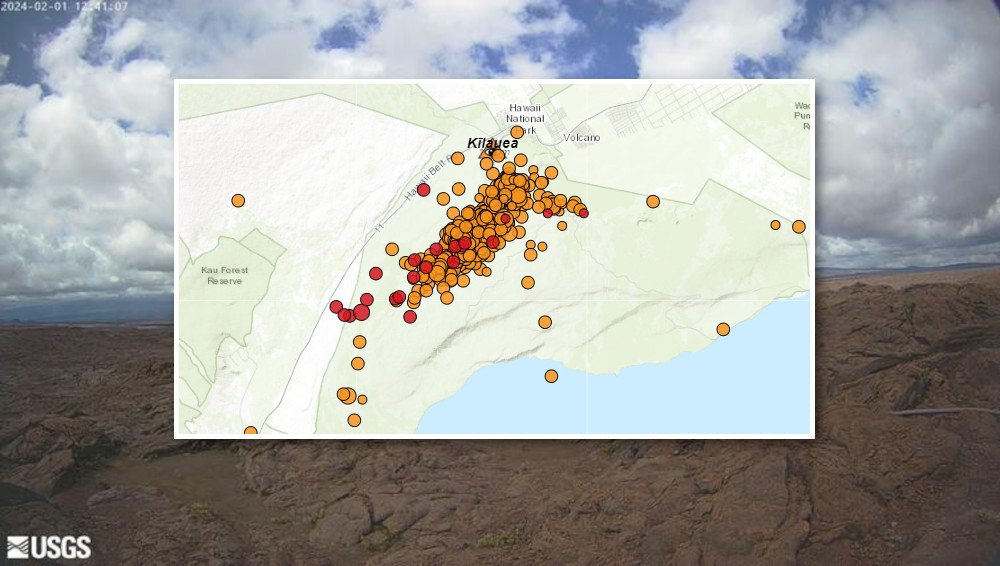(BIVN) – Kīlauea volcano is not erupting, but the renewed unrest continues, and has shifted away from the summit to the southwest.
The volcano alert level was raised from ADVISORY to WATCH on January 31st, with an increase in seismicity and deformation in the summit region. As of Thursday, the earthquake activity has become concentrated along the Koa‘e fault system southwest of the summit.
The USGS Hawaiian Volcano Observatory says Kīlauea’s summit remains pressurized, and reminded the public that in recent months unrest has escalated quickly, “and an eruption could occur in the future with little warning.”
With the latest shift in activity, scientists noted that “based on past historical activity, this event is much more likely to continue as an intrusion, but there is still a possibility of it ending in an eruption.”
From the USGS HVO update on Thursday morning:
Summit Observations: As of this morning, seismicity in the south caldera region has quieted, and activity is concentrated 5-7 miles (8-11 km) southwest of the caldera, in the vicinity of Pu‘ukoa‘e. Depths have remained consistent, 1–4 km (less than a mile–2.5 mi) below the surface, and the rates have persisted at 25-30 locatable earthquakes per hour. There have been over 70 locatable earthquakes in this region in the past 3 hours, with magnitudes ranging from a maximum of 3 to less than 1. Some events are large enough to be felt by neighboring communities, though none have been large enough to cause damage.
Kīlauea’s summit region remains at a high level of inflation. Nearly 40 microradians of change have been recorded since 4:00 a.m. HST on January 31 at tiltmeters near Sand Hill and Uēkahuna bluff. Both of these tiltmeters showed highly variable directions and rates of tilt on January 31, typical of shallow crack growth that can precede either an eruption or shallow intrusion. Since early this morning, these tiltmeters have shown more consistent directions and rates, suggestive of ground inflation to the southwest (in the direction of where earthquakes are occurring). Step-wise offsets in the tilt signal are likely due to the instrument being shaken by nearby earthquakes or rockfalls.
Sulfur dioxide (SO2) gas emission rates remain low. Field measurements indicated an SO2 emission rate of approximately 70 tonnes per day on January 17, which was similar to measurements in October, November, and early December.
Patterns of earthquakes and ground deformation since this morning indicate that pulses of magma continue to move beneath the surface of southwest of the summit along the Ko’ae fault zone. The Koa‘e fault system connects Kīlauea’s East and Southwest Rift Zones south of the caldera. Faults here appear as low cliffs, or “scarps.” Typically, when magma reaches this area earthquakes are concentrated at depths of 3-4 km (2-2.5 mi), but current activity is distributed more evenly from 1-4 km (less than a mile–2.5 mi) depth. Around 7:30 this morning, three magnitude 2.9 earthquakes occurred just south of Puʻukoʻae at very shallow depths. At the time of this report, activity remains elevated; periods of increased earthquake activity and rates of ground deformation can be expected to continue in this region. Based on past historical activity, this event is much more likely to continue as an intrusion, but there is still a possibility of it ending in an eruption.
The USGS HVO also noted that recent upgrades to their network are “causing intermittent outages that are affecting public access to monitoring data.” The scientists say they still have internal access to volcano monitoring data, and they will continue to report on volcanic activity. “We apologize for any inconvenience during this dynamic time,” the Observatory said.


by Big Island Video News1:24 pm
on at
STORY SUMMARY
HAWAIʻI VOLCANOES NATIONAL PARK - Since last night, earthquake activity has concentrated along the Koa‘e fault system southwest of the summit, scientists say.